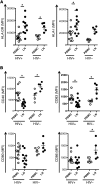IL-10 induces aberrant deletion of dendritic cells by natural killer cells in the context of HIV infection
- PMID: 20440075
- PMCID: PMC2877944
- DOI: 10.1172/JCI40913
IL-10 induces aberrant deletion of dendritic cells by natural killer cells in the context of HIV infection
Abstract
Persistent levels of IL-10 play a central role in progressive immune dysfunction associated with chronic viral infections such as HIV, but the underlying mechanisms are poorly understood. Because IL-10 affects the phenotypic and functional properties of DCs, which are responsible for initiating adaptive immune responses, we investigated whether IL-10 induces changes in DC phenotype and function in the context of HIV infection. Here, we show that IL-10 treatment of immature and mature human DCs in culture induced contrasting phenotypic changes in these populations: immature DCs exhibited aberrant resistance to NK cell-mediated elimination, whereas mature DCs exhibited increased susceptibility to NKG2D-dependent NK elimination. Treatment of immature and mature DCs with HIV resulted in potent IL-10 secretion and the same phenotypic and functional changes observed in the IL-10-treated cells. Consistent with these in vitro data, LNs isolated from individuals infected with HIV exhibited aberrant accumulation of a partially "immature" DC population. Together, these data suggest that the progressive immune dysfunction observed in chronic viral infections might be caused in part by IL-10-induced reversal of DC susceptibility to NK cell-mediated elimination, resulting in the accumulation of poorly immunogenic DCs in LNs, the sites of adaptive immune response induction.
Figures





Similar articles
-
Escape of HIV-1-infected dendritic cells from TRAIL-mediated NK cell cytotoxicity during NK-DC cross-talk--a pivotal role of HMGB1.PLoS Pathog. 2010 Apr 15;6(4):e1000862. doi: 10.1371/journal.ppat.1000862. PLoS Pathog. 2010. PMID: 20419158 Free PMC article.
-
HMGB1-dependent triggering of HIV-1 replication and persistence in dendritic cells as a consequence of NK-DC cross-talk.PLoS One. 2008;3(10):e3601. doi: 10.1371/journal.pone.0003601. Epub 2008 Oct 31. PLoS One. 2008. PMID: 18974890 Free PMC article.
-
Dendritic cells in innate immune responses against HIV.Curr Mol Med. 2002 Dec;2(8):739-56. doi: 10.2174/1566524023361907. Curr Mol Med. 2002. PMID: 12462394 Review.
-
Virally infected and matured human dendritic cells activate natural killer cells via cooperative activity of plasma membrane-bound TNF and IL-15.Blood. 2010 Jul 29;116(4):575-83. doi: 10.1182/blood-2009-08-240325. Epub 2010 Apr 29. Blood. 2010. PMID: 20430958 Free PMC article.
-
Mutiny or scrutiny: NK cell modulation of DC function in HIV-1 infection.Trends Immunol. 2011 May;32(5):219-24. doi: 10.1016/j.it.2011.02.003. Epub 2011 Mar 14. Trends Immunol. 2011. PMID: 21411368 Free PMC article. Review.
Cited by
-
Contribution of Dendritic Cell Responses to Sepsis-Induced Immunosuppression and to Susceptibility to Secondary Pneumonia.Front Immunol. 2018 Nov 13;9:2590. doi: 10.3389/fimmu.2018.02590. eCollection 2018. Front Immunol. 2018. PMID: 30483258 Free PMC article. Review.
-
Hyaluronan digestion controls DC migration from the skin.J Clin Invest. 2014 Mar;124(3):1309-19. doi: 10.1172/JCI67947. J Clin Invest. 2014. PMID: 24487587 Free PMC article.
-
The Biology of Monocytes and Dendritic Cells: Contribution to HIV Pathogenesis.Viruses. 2018 Feb 6;10(2):65. doi: 10.3390/v10020065. Viruses. 2018. PMID: 29415518 Free PMC article. Review.
-
Identification of three immunologic correlates for HIV type 1 pathogenesis in youth.AIDS Res Hum Retroviruses. 2011 Jun;27(6):639-46. doi: 10.1089/AID.2010.0161. Epub 2010 Dec 13. AIDS Res Hum Retroviruses. 2011. PMID: 20969482 Free PMC article.
-
Attenuation of innate immunity by cytomegalovirus IL-10 establishes a long-term deficit of adaptive antiviral immunity.Proc Natl Acad Sci U S A. 2010 Dec 28;107(52):22647-52. doi: 10.1073/pnas.1013794108. Epub 2010 Dec 13. Proc Natl Acad Sci U S A. 2010. PMID: 21149711 Free PMC article.

